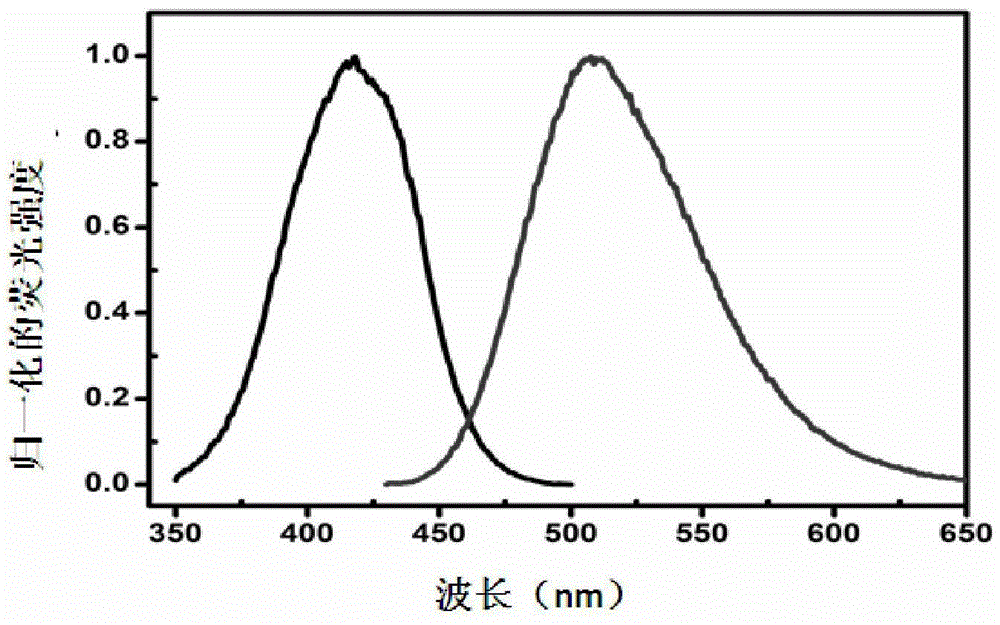A kind of germanium nanocluster, its preparation method and use
A nano-cluster, germanium dioxide technology, applied in chemical instruments and methods, fluorescence/phosphorescence, luminescent materials, etc., can solve the application limitations in the field of optical and optoelectronic devices, low fluorescence quantum yield, and no semiconductor metal clusters are seen. Cluster reporting, etc.
- Summary
- Abstract
- Description
- Claims
- Application Information
AI Technical Summary
Problems solved by technology
Method used
Image
Examples
Embodiment 1
[0068] Synthesize water-soluble germanium clusters as follows:
[0069] (1) Weigh 0.06g of sodium hydroxide and dissolve it in 10ml of water, and ultrasonically dissolve it to make a sodium hydroxide solution;
[0070] (2) Weigh 0.26g germanium dioxide (GeO 2 , purchased from Sigma-Aldrich Shanghai Trading Co., Ltd., product number 483702) was dissolved in the sodium hydroxide solution in step (1), and ultrasonically dissolved to obtain a germanium source solution;
[0071] (3) Dissolving the germanium source in a sodium hydroxide solution under ultrasonic radiation conditions to prepare a germanium source solution, and adjusting the pH value of the germanium source solution in step (2) to between 6 and 7 with dilute hydrochloric acid;
[0072] (4) Add 1.21g of cysteine (purchased from Sigma Aldrich Shanghai Trading Co., Ltd., product number 30089-25G) into 9ml of ultrapure water, stir to fully dissolve cysteine, and prepare cysteine The aqueous solution; The concentration...
Embodiment 2
[0081] In this example, germanium clusters were prepared according to the same method as in Example 1, the only difference being that the amount of cysteine used was 0.121 g.
[0082] According to the same characterization method in Example 1, the fluorescence spectrum of the germanium clusters obtained in this comparative example is very different from Example 1 by using a fluorescence spectrometer, the emission peak position is red-shifted to 530nm, and the excitation peak position is blue-shifted to 385nm. Using sodium fluorescein as a fluorescent standard substance to measure the fluorescence quantum yield of the germanium clusters obtained in this embodiment is above 20%, indicating that the proportioning concentration of cysteine and germanium sources has a certain effect on the fluorescent properties of the synthesized clusters. Impact.
Embodiment 3
[0084] (1) Weigh 0.02g of potassium hydroxide and dissolve it in 10ml of water, and ultrasonically dissolve it to make sodium hydroxide solution;
[0085] (2) Weigh 0.026g germanium dioxide (GeO 2 , purchased from Sigma-Aldrich Shanghai Trading Co., Ltd., product number 483702) was dissolved in the sodium hydroxide solution in step (1), and ultrasonically dissolved to obtain a germanium source solution;
[0086] (3) Under the condition of ultrasonic radiation, dissolving the germanium source in a sodium hydroxide solution to prepare a germanium source solution, and adjusting the pH value of the germanium source solution in step (2) to 9 with dilute hydrochloric acid;
[0087] (4) Add 0.0605g of cysteine (purchased from Sigma-Aldrich Shanghai Trading Co., Ltd., product number 30089-25G) into 9ml of ultrapure water, stir to fully dissolve cysteine, and prepare cysteine The aqueous solution; The concentration of the aqueous solution of cysteine is 0.05mmol / ml;
[0088] (5) ...
PUM
| Property | Measurement | Unit |
|---|---|---|
| concentration | aaaaa | aaaaa |
| size | aaaaa | aaaaa |
Abstract
Description
Claims
Application Information
 Login to View More
Login to View More - R&D
- Intellectual Property
- Life Sciences
- Materials
- Tech Scout
- Unparalleled Data Quality
- Higher Quality Content
- 60% Fewer Hallucinations
Browse by: Latest US Patents, China's latest patents, Technical Efficacy Thesaurus, Application Domain, Technology Topic, Popular Technical Reports.
© 2025 PatSnap. All rights reserved.Legal|Privacy policy|Modern Slavery Act Transparency Statement|Sitemap|About US| Contact US: help@patsnap.com



